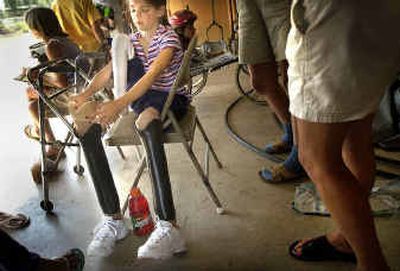Young athletes test their limitations

Racheal Ceniceros walked a mile Wednesday without her feet for the Team St. Luke’s Push-A-Thon. Before she was born, her umbilical cord wrapped around her lower legs, which left them severely disabled. Four months ago, surgeons completed the removal of the bones and tissue from the 11-year-old girl’s feet, leaving her legs and the firm heels. She received new artificial legs and feet Tuesday that fit onto her legs. With her older teen sister by her side, Ceniceros joined 20 other athletes at the Whitworth College track who counted off laps to raise cash for their pending trip to a national track competition in Mesa, Ariz. The Junior Disabled Sport Championships will cost the team $23,000 for registration, airfare, food, lodging and ground transportation – all by July 10. Organizers weren’t sure how much cash they raised, but they were confident it would all work out. “Every year people have pulled through for us,” said Teresa Skinner, Team St. Luke’s coordinator. The young athletes did their best under the oppressive heat. Skinner said it was good preparation for their Arizona competition. They came from places including Tekoa, Spokane and Fairfield. Ceniceros was the only double amputee rounding the track. The dark-haired girl with a blue scrunchie pulling back her ponytail rested in the shade of an equipment shed between laps. She said her heels were purple and getting sore from three laps. After a 20-minute break, Skinner said Ceniceros had one lap to go. “Come on, girl,” Skinner said. And with some urging and a last drink of water, Ceniceros was up behind her walker. The first 80 yards went slower than most of the day, especially when her walker tipped over and she took a tumble. She adjusted her legs and got back up. “It’s taking too much out of me,” Ceniceros said, with 300 more yards to go. Trainers kept their eyes on the sisters from across the track. Being tough on the children helps them learn to rely on themselves, they say. “Sometimes the best thing you can do for them is not do anything at all,” Skinner said, repeating a familiar refrain among occupational therapists. Skinner has seen firsthand how children respond to sports therapy. Many children with disabilities grow up having everything done for them, she said. It’s a natural response for parents when doctors say their child will be lucky to see their fifth birthday. But sports shows kids how much they can do. “It’s amazing how much they change,” Skinner said. “I see it each week.” Bob Hunt, 14, weighs 40 pounds and can manage about 12 feet in the shot put. He’s a Bloomsday regular and has muscular arms that show his years of training. Hunt has sacral agenisis, a disease in which vertebrae do not connect to his pelvis. He’s been training with Skinner for about five years. Hunt did 29 laps in a race wheelchair Wednesday to raise money from 34 sponsors he signed up. Still on the track, with 200 yards to go, Ceniceros started into a rhythm. Her stroller no longer strayed too far ahead – a problem that had at times forced her to scurry quickly to keep her balance. With 100 yards to go, she’d take her hands off her support and push the stroller with her waist. Her sister cheered as the sun fell behind a cloud. Ceniceros’ heavy legs were almost done for the day. Then, without fanfare, she completed her final lap and continued back to the shady shed to sit on the bench press bench, where she laid back flat. “When I get home I’m taking the longest nap ever,” Ceniceros said.